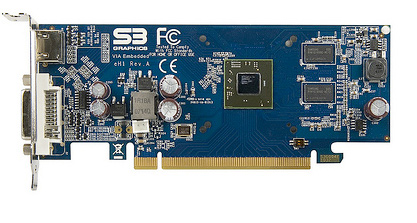VIA Launches eH1 GPU For Embedded Systems
There was once a time where notebooks were no good for gaming. And now, that time has passed. There was once a time where embedded machines weren't even capable of displaying graphics that were even the slightest bit intense. And now, that time has also passed. VIA has today launched the eH1, the embedded industry's first dedicated graphics card.

This card offers DirectX 10.1 support, multi-screen HD video support and more graphical horsepower than most embedded systems could dream of. The system needs a PCI Express slot for the eH1 to fit into, but that's it. It uses a DirectX 10.1, OpenGL 3.1, OpenGL ES 2.0 compatible 64-bit architecture and offers multi-stream 1080p HD video decoding and Stereoscopic 3D rendering, and it features the S3 Chrome 5400E GPU at its heart.
That's a 64-bit discrete graphics solution with 512MB of DDR3 memory. You'll also find DVI and HDMI outputs, and it can be used n conjunction with a number of VIA EPIA board products and can supplement any existing system that uses a x1, x4, x8 or x16 PCIe slot. Samples of the board are available now, and we assume that a public on-sale date will be announced soon.


This card offers DirectX 10.1 support, multi-screen HD video support and more graphical horsepower than most embedded systems could dream of. The system needs a PCI Express slot for the eH1 to fit into, but that's it. It uses a DirectX 10.1, OpenGL 3.1, OpenGL ES 2.0 compatible 64-bit architecture and offers multi-stream 1080p HD video decoding and Stereoscopic 3D rendering, and it features the S3 Chrome 5400E GPU at its heart.
That's a 64-bit discrete graphics solution with 512MB of DDR3 memory. You'll also find DVI and HDMI outputs, and it can be used n conjunction with a number of VIA EPIA board products and can supplement any existing system that uses a x1, x4, x8 or x16 PCIe slot. Samples of the board are available now, and we assume that a public on-sale date will be announced soon.

VIA Launches VIA eH1, Embedded Industry's First
Dedicated Graphics Card
VIA eH1 graphics card offers DX10.1 graphics and multi-screen HD video content for embedded systems
TAIPEI, TAIWAN, January 3, 2011 - VIA Technologies, Inc, a leading innovator of power efficient x86 processor platforms, today announced the world's first graphics card designed specifically for the embedded market with the VIA eH1, a DX10.1 compliant, multi-display card that thrusts any system with a PCI Express slot into a new realm of graphics and video capability.
The VIA eH1 comes with a three year product longevity guarantee and is the most power-efficient discrete graphics and video solution on the market today. The VIA eH1 AIB features an advanced DirectX 10.1, OpenGL 3.1, OpenGL ES 2.0 compatible 64-bit architecture and offers multi-stream 1080p HD video decoding and Stereoscopic 3D rendering capability. This makes it the ideal solution for a range of embedded applications that require advanced graphics and video on multiple displays.
"The VIA eH1 hits a real sweet spot for the embedded industry as a whole," said Daniel Wu, Vice President, VIA Embedded Platform Division, VIA Technologies, Inc. "Offering technologies like DX10.1, OpenGL/CL, plus multi-channel HD video playback on an extremely low power AIB will excite system integrators who want to bring the latest features to existing platforms."
VIA eH1: Embedded Graphics and Video
The VIA eH1 is a low profile PCI Express add-in-board designed for next generation embedded applications in a range of segments including digital signage and advertising, POS, POI, gaming or any embedded application where sophisticated graphics and HD video is streamed on two displays.
The VIA eH1 features the S3 Chrome 5400E GPU, the industry's most power-efficient a 64-bit discrete graphics solution and is complimented with 512MB of DDR3 memory.
VIA eH1 Product Highlights
· PCIe 2.0 Bus Interface
· 512MB DDR3
· Low profile form factor
· Dual-Link DVI and HDMI (with HDCP)
· Fully programmable DirectX 10.1 Unified Shader Core
· OpenGL 3.1 + OpenGL ES 2.0
· GPGPU on OpenCL 1.0
· H.264 and VC-1 support for Blu-Ray
· Support for resolutions up to 2560x1600
· 1080p/1080i/720p HD-decode
· Steroscopic 3D capable
· Dual display support
The VIA eH1 can be used in conjunction with a number of VIA EPIA board products and can supplement any existing system that uses a x1, x4, x8 or x16 PCIe slot. Samples of the VIA eH1 are available now to project customers upon request.
For more information about the VIA eH1 please visit:
http://www.via.com.tw/en/products/embedded/graphics/eh1/index.jsp
Details regarding the S3 Chrome 5400E can be found on the S3 Graphics website here: http://www.s3graphics.com/en/products/class2.aspx?seriesId=17

